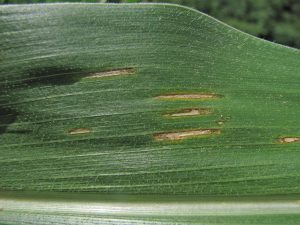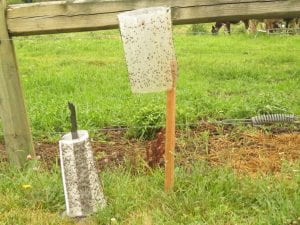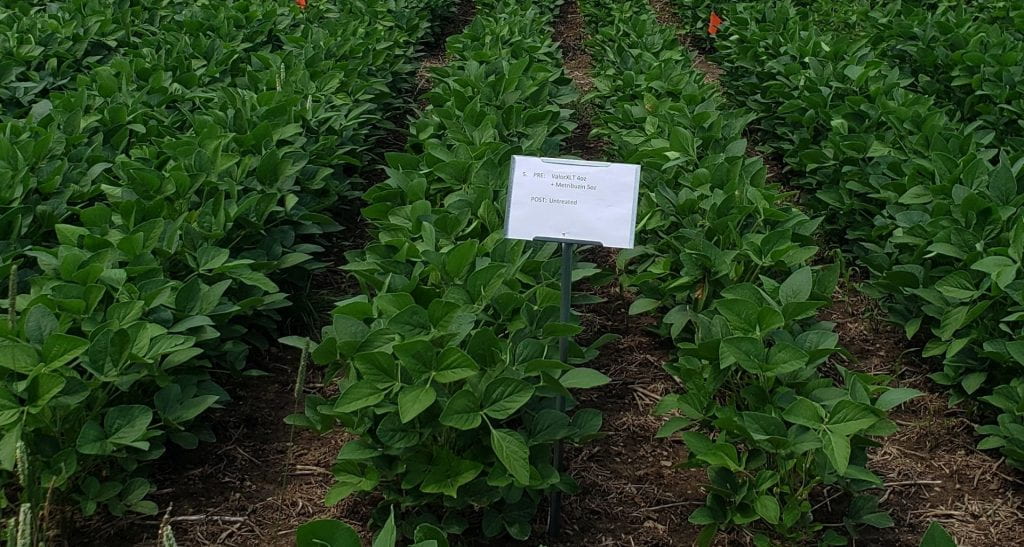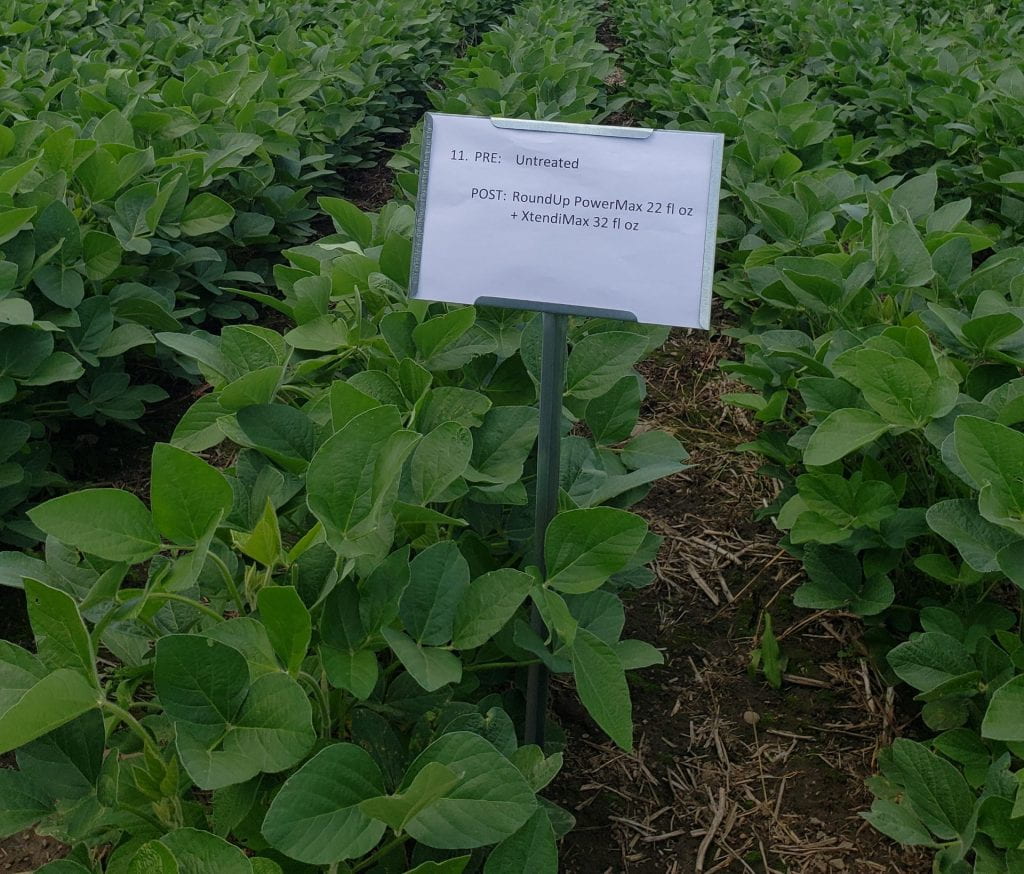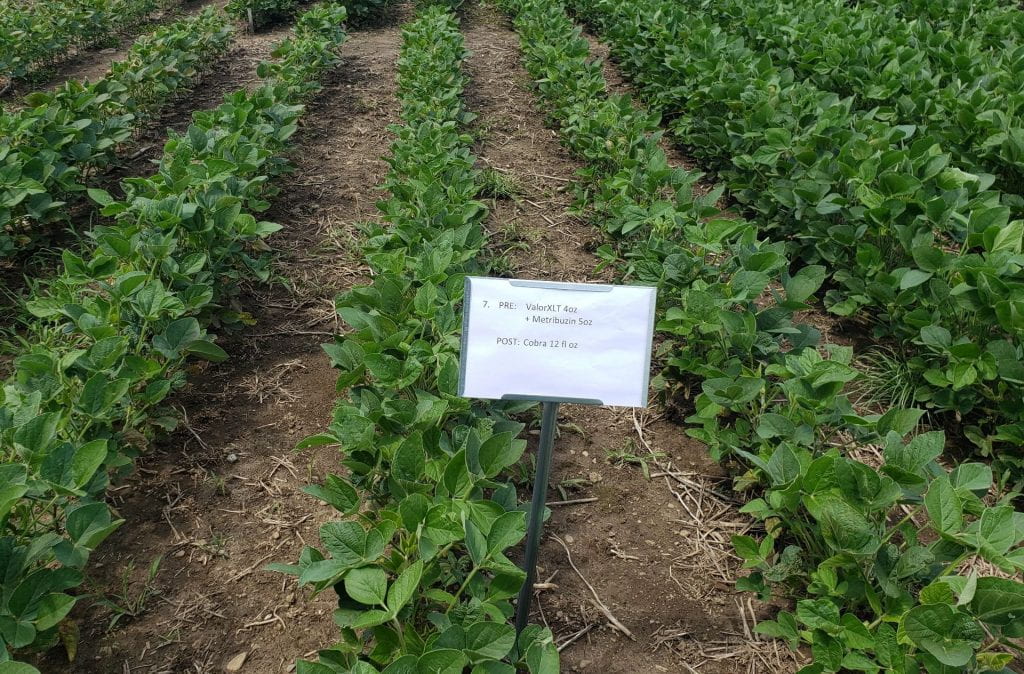NYS IPM Weekly Field Crops Pest Report, August 7, 2019
Volume 18, Number 14
View from the Field
Potato Leafhopper (Empoasca fabae)
There are continued reports of potato leafhopper (Empoasca fabae) (PLH) potato leafhopper over threshold in several fields across NY. For information on scouting/monitoring PLH in alfalfa, view the following video:
IPM for potato leafhopper in alfalfa-Video
Gray Leafspot (Cercospora zeae-maydis)
Aaron Gabriel (CCE Central NY) reports finding a little bit of gray leaf spot (Cercospora zeae-maydis) on corn. It is a good idea to keep an eye out on this and scout your fields for the disease especially in river valleys with rainy conditions.
Early symptoms: yellow to tan lesions with a light watery halo. As the lesion progresses, it turns brown and is rectangular, between the veins. When fully developed the lesion can be 3 to 4 inches long and a 1/6 to 1/8 inch wide.
The fungus can overwinter on corn debris left on the soil surface. Sporulation occurs during warm and humid weather in late spring. The spores can be transmitted by both wind and rain. In some cases, gray leaf spot can reduce corn yields from 5 to 40 bushels per acre.
Here are a few steps to follow when making a decision to use a fungicide:
- Scout fields for the gray leaf at tasseling. If there are lesions on leaves at or above the corn ear exceeding 5% of the plant leaf area consider a fungicide. If lesions develop later after tasseling, then economic benefits from using a fungicide will be less.
- Does your hybrid have at least moderate resistance? This can make a big difference in yield and likely will not require a fungicide application. Disease symptoms may be present in resistant corn, but a fungicide most likely will not increase yield.
- Crop rotation and tillage is an effective method to control the fungi. The longer the rotation the less inoculum will be on the surface. If you maintain no-tillage, zone-tillage or reduced tillage rotating away from corn for 2 years can help reduce pathogen populations.
- Fungicides can be very effective when disease exists above the economic threshold. However, fungicides are protective, not curative, so applications need to be made before the full extent of disease damage is known. It is generally not economical to spray fungicide on silage corn.
Stable Fly Traps Dairy Demonstration Data
Stable flies reproduce and develop in moist rotting organic matter. This includes moist, hay, straw, manure, feed or any rotting material in contact with the ground (soil or concrete). Stable flies need to take blood meals to reproduce. These flies like to bite the legs of the animals. They look similar to a housefly but have a moth part the can pierce the skin can and take blood. We have been demonstrating two stable flytraps on Shun Pike Dairy in Dutchess County. One is the Olson Biting Fly Trap and the second is the Knight Stick from Bug Jammer.
Knight Stick (stable flies are attracted to a blue spectrum of light that is reflected)
Olson Biting Fly Trap Trap (stable flies are attracted to a blue spectrum of light that is reflected)
We have been collecting data weekly on these traps. The Knight stick is more attractive but catches fewer flies because the Olson Trap has a lot more surface area.
Weather Outlook – August 2, 2018
Jessica Spaccio
NOAA Northeast Regional Climate Center, Cornell University
Last week temperatures ranged from near normal to 4 degrees above normal. Precipitation has ranged from a hundredth of an inch to 1 ½ inches. Base 50 growing degree-days ranged from 110 to 170.
Near normal weather for the next week.
For next week temperatures will run just a degree or two above normal with highs in the upper 70s to upper 80s across the state and lows in the upper 50s to upper 60. The best chances of rain are Saturday and then next Tuesday/Wednesday. Overall, do not expect any high rainfall amounts
The seven-day precipitation amounts will range from a hundredth of an inch to one inch.
The 8-14 day outlook (August 8-14) favors below-normal temperatures for most of the state. The precipitation outlook favors near-normal precipitation for most of the state, with slightly below-normal amounts for eastern areas of the state.
National Weather Service watch/warnings map
Roundup Resistant Waterhemp Trial
Jeff Miller: (CCE Oneida County) There was a field day at a herbicide demonstration trial for managing herbicide resistant weeds last week. The trial is facilitated by Bryan Brown (NYS IPM), Mike Hunter (CCE), Jeff Miller (CCE), Mike Stanyard (CCE Northwest Dairy and Field Crops Team) and Venancio Fernandez (Bayer). Growers, extension educators and industry reps attended the demonstration to observe the efficacy of a number of treatments to manage these difficult weeds. Below is a message and summary from Jeff Miller of Oneida County CCE:
For growers who don’t have glyphosate resistant waterhemp, by far the most effective and economical program is glyphosate alone even if you are using the highest rate.
If you are seeing horsenettle, milkweed, dogbane, field bindweed and other broadleaf perennials, moving to extendimax and roundup in one growing season might help to clean up these weeds when combined with an appropriate herbicide program in corn the following year.
Waterhemp, unlike marestail, drops its seed close to the plant. There isn’t much, if any, off site movement except with the harvested crop on equipment and maybe your shoes. So this is a localized issue for now.
What I gleaned from the study given the treatments that were applied;
The pre-emergence application of Valor xlt and metribuzin controlled the waterhemp and other grass and broadleaf weeds found on the site at an approximate cost of $32/acre including a $13 application fee.
The post-emergence only treatment of Roundup Powermax and XtendiMax (low volatile Banvel) was also successful at controlling the waterhemp and other grasses and broadleaf weeds on the site. You will note the rating for water hemp control was lower than the Valor xlt + metribuzin pre-emergence application. That is because the post treatment was applied July 5th and the rating was conducted on July 19th. I think we all expect that the later rating results will improve. But this does underline the fact that weeds are controlled later in the season……what is the impact from this delay???
The other treatment to look at is the Cobra treatment. Bryan and Venancio have gained insights from this season, and are planning to change treatments next year to look at different combinations that may provide effective control at lower cost.
See attached the handout with the ratings of control on June 26 and July 19. One more rating is planned later this season. The cost of the different programs and other useful information is included.
Here are some pictures of some key treatments
Western Bean Cutworm Data (8/7/10)
Clipboard Checklist
Keith Waldron, NYS IPM
General
*Walk fields to check general field condition, weed, vertebrate and other issues
*Watch for crop maturity, stand assessments, weed escapes, nutrient deficiencies, lodging issues
Alfalfa:
*Evaluate established legume stands for approximate days until harvest
*Monitor potato leafhopper, foliar, systemic and crown rot diseases.
*Monitor new seedings for potato leafhopper, pythium blight, phytopthora root rot.
Small Grains:
*Monitor grain fields for growth stage, disease and lodging issues, grain maturity, harvest timing
*Record diseases present, location and types of weed escapes
Corn:
*Monitor for mid-season corn pests including European corn borer, corn rootworm, western bean cutworm, slugs, foliar diseases such as northern corn leaf blight and gray leaf spot, weed issues, nutrient deficiencies, vertebrate damage.
Soybeans:
*Monitor for soybean aphid, defoliators, foliar diseases, white mold, weed issues, vertebrate damage
Pastures:
*Check water sources, mend fences as needed.
*Check crop growth, clip pastures between grazing as needed
*Monitor for invasive species, plants harmful to livestock
*Review/Plan rotations
Storage:
* Check stored grain bins for temperature, moisture and signs of mold and insects. Aerate, core, transfer grain or treat as necessary
* Clean and disinfect empty storage bins in preparation for grain harvest
*Check forage allocation and anticipate feed program adjustments as forages from previous year are used up
*Mow around storage bins and facility to minimize pest hiding places
Dairy Cattle Barn Fly Management:
*Monitor animals and barn area for house fly, stable fly and other pest management needs including presence of rodents and birds.
*Check facilities for favorable fly breeding conditions: (organic matter + moisture): leaks in watering systems, roof gutters for leaks and potential overspill, drainage,
*Sanitation, sanitation, sanitation – clean animal resting areas, feed troughs, minimize source of moist organic matter i.e. fly breeding areas in barn and in adjacent animal loafing yard
* Continue fly monitoring: install “3X5″ index card fly speck monitoring cards throughout barn
*Use, replenish, replace fly management materials: sticky fly tapes/ribbons, insecticide baits, natural enemies (parasitoids), fly population monitoring (3 x 5) spot cards
*Consider purchase and release of Muscidifurax raptor and/or M. raptorellus natural enemies of house and stable fly pupae.
Dairy Cattle on Pasture:
*Monitor animals for presence of face flies, horn flies and stable flies. Action guidelines: face flies (average 10 per animal face), horn flies (average 50 / dairy per animal side, 200 / beef cattle per animal side), stable flies average 10 per animal (all four legs)
*Check feed bunk / water source locations for signs of stable fly breeding (moist undisturbed organic matter – spilled feed, round bales, etc.), minimize source of moist organic matter i.e. fly breeding areas in barn and in adjacent animal exercise yard.
*Check pasture for forage quality / quantity, rotate as appropriate
*Check pasture for vegetation poisonous to livestock
*Consider use of pasture fly traps to help reduce deer, horse and stable fly populations


